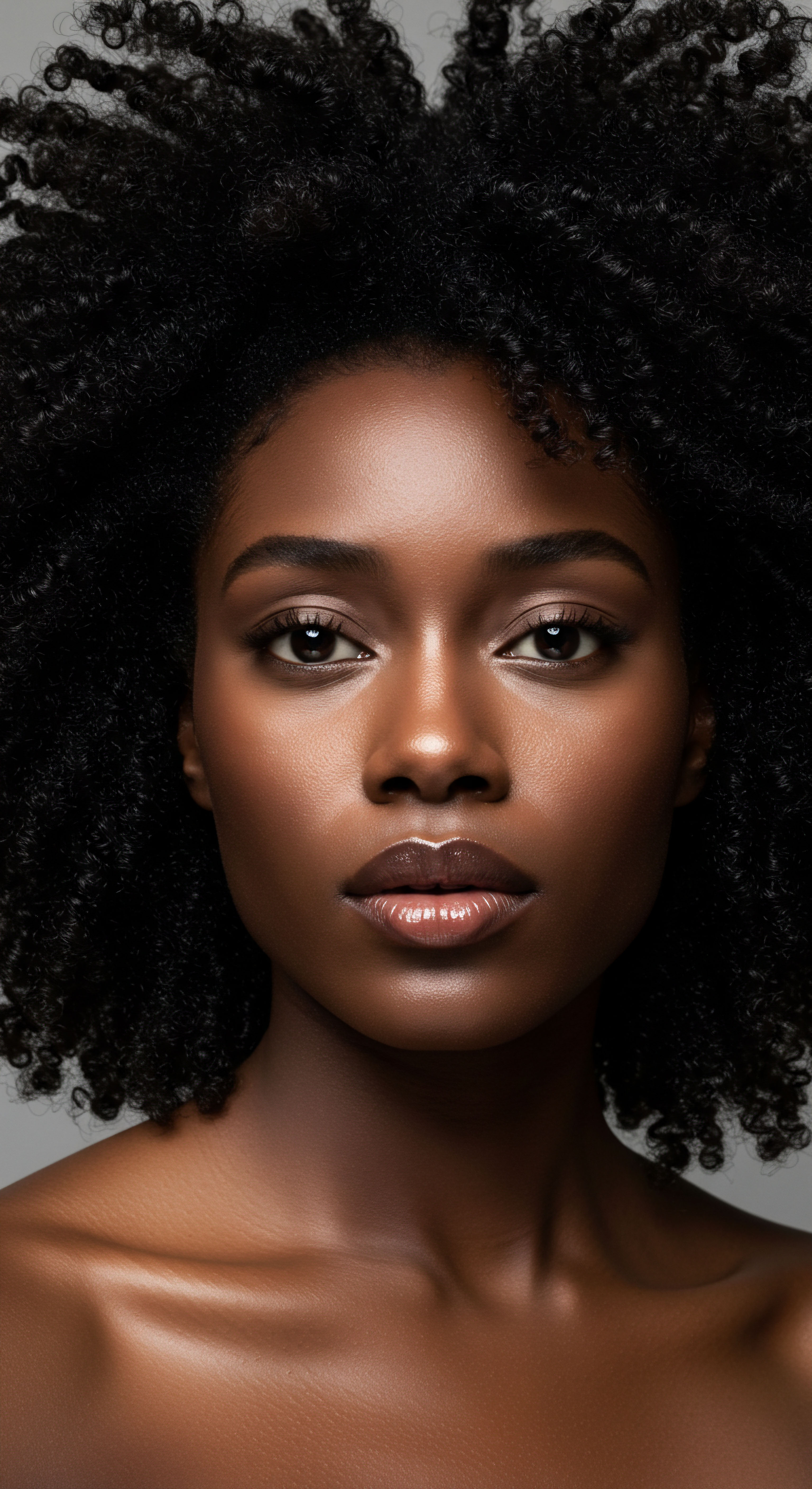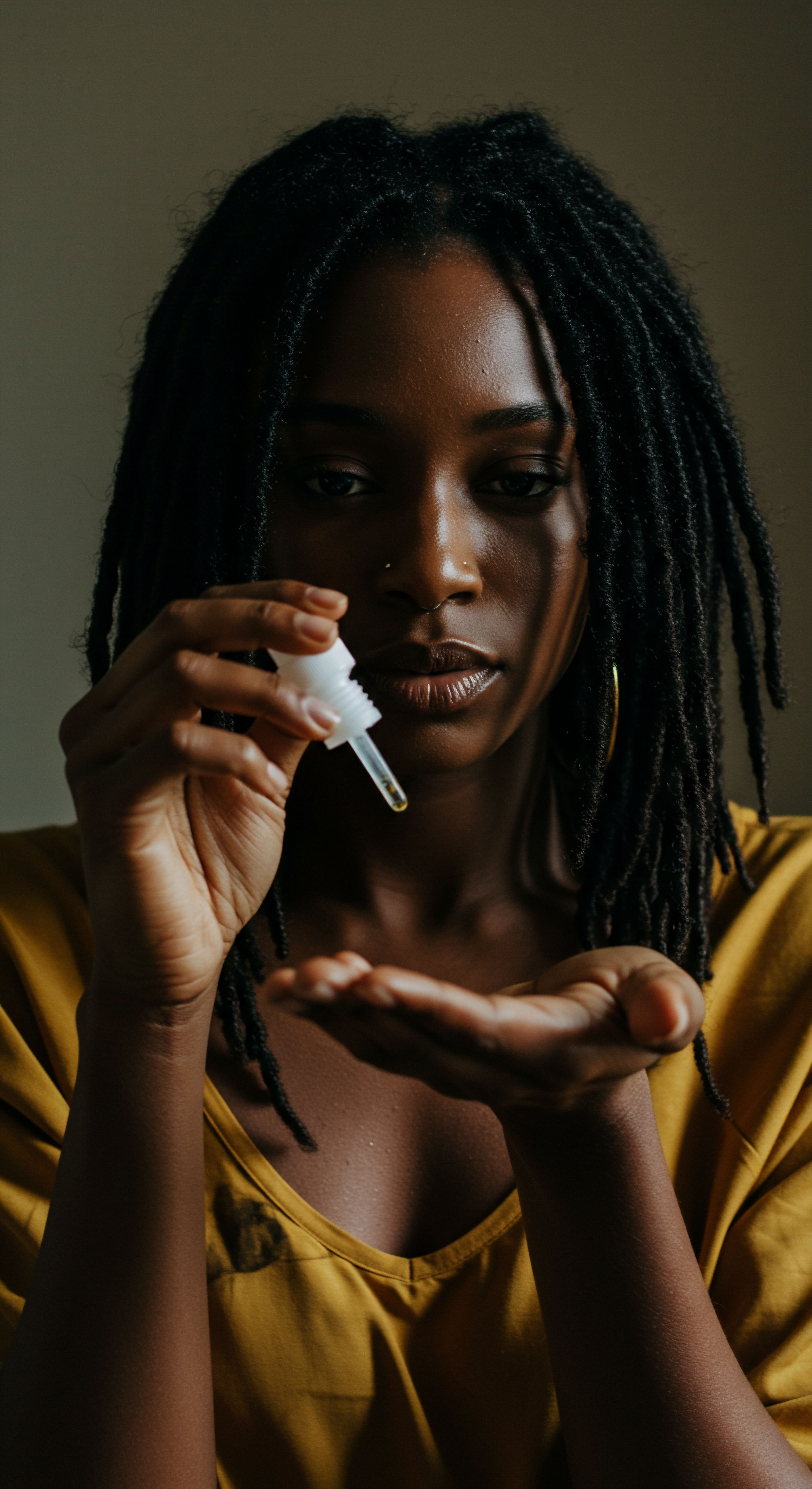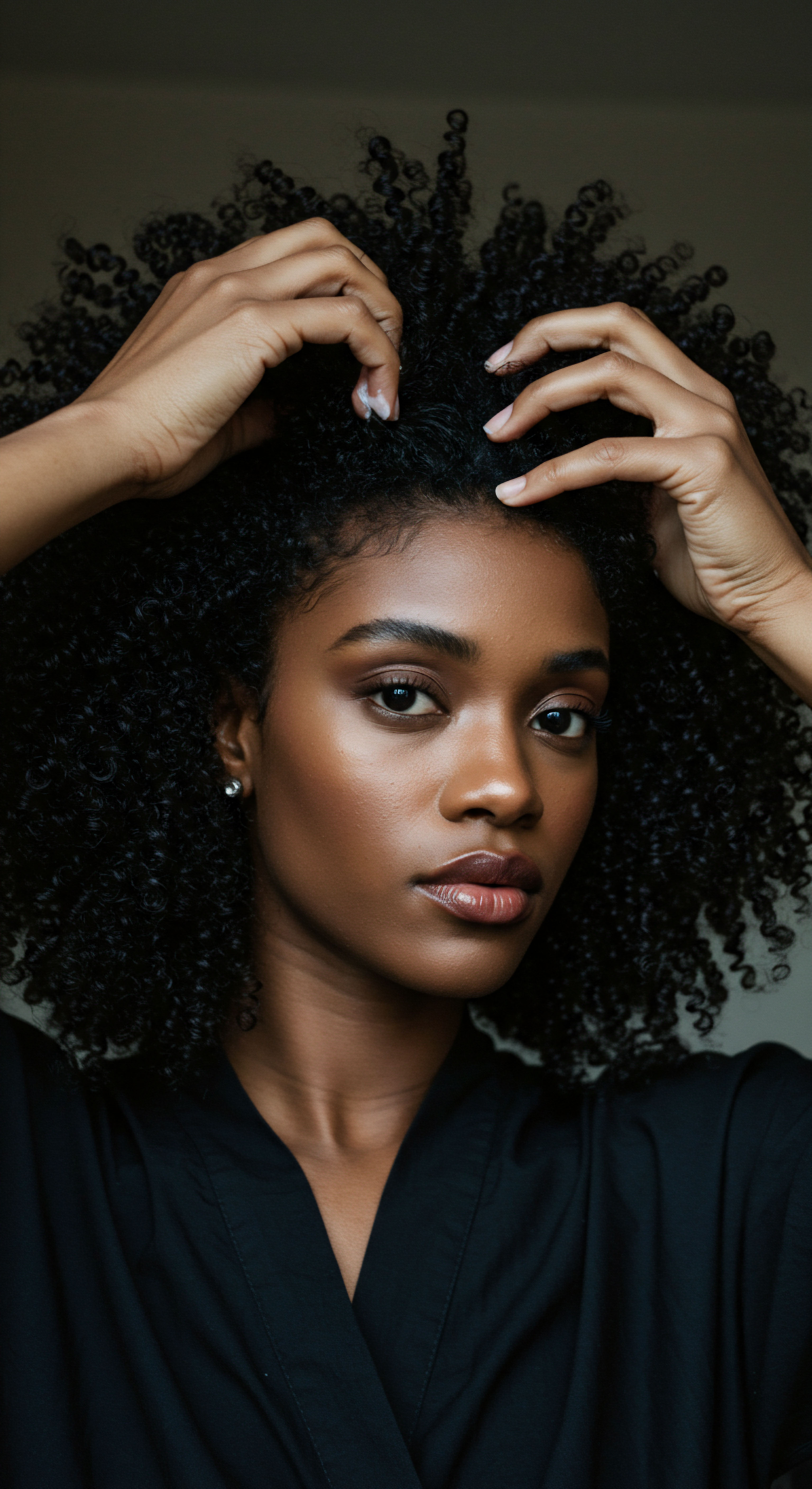
Fundamentals
The journey of shea butter, from the sun-drenched savannas of West Africa to the cherished rituals of textured hair care across the globe, begins with an understanding of its very genesis. Shea butter sourcing, at its simplest, is the initial step in this remarkable process ❉ the gathering of nuts from the Vitellaria Paradoxa Tree, commonly known as the shea tree. This magnificent tree, indigenous to the vast “Shea Belt” stretching across more than 20 African nations, generously offers its fruit, within which lies the precious kernel destined to become the nourishing butter we hold dear.
This primary act of collection is more than a mere agricultural chore; it represents a deep connection to ancestral practices and ecological rhythms. For centuries, the shea tree has stood as a symbol of life and sustenance within these communities. The nuts, resembling small plums, ripen and fall naturally to the earth, typically between May and August, signifying the start of the harvesting season.
Local women, often organized into cooperatives, then carefully collect these fallen fruits, a tradition passed down through generations. This collection is the foundational element, setting the stage for all subsequent transformations.
Shea butter sourcing initiates with the seasonal gathering of nuts from the shea tree, a tradition deeply embedded in West African communities.

Traditional Extraction ❉ A Legacy of Hands
Following collection, the journey continues with the traditional extraction of the butter, a process that embodies a blend of careful labor and community spirit. This method, largely unchanged for centuries, ensures the preservation of the shea butter’s natural properties, making it a highly valued ingredient, particularly for those tending to textured, Black, and mixed-race hair. The process typically involves several key stages, each contributing to the butter’s distinctive character.
- Drying ❉ The freshly collected shea nuts are first sun-dried for several days, a natural method to reduce moisture content and prevent spoilage. This step is vital for preparing the kernels for the subsequent stages of processing.
- Cracking and Roasting ❉ Once adequately dried, the nuts are cracked to separate the kernels from their outer shells. These kernels are then often roasted over an open fire, a practice that enhances the butter yield and imparts the characteristic nutty aroma associated with traditional shea butter.
- Grinding and Kneading ❉ The roasted kernels are ground into a thick paste, often using traditional grinding stones or mechanical mills. Water is gradually added to this paste, which is then vigorously kneaded by hand. This labor-intensive step is crucial, facilitating the separation of the butter from the remaining paste.
- Boiling and Skimming ❉ The mixture is boiled, causing the rich fat—the shea butter—to rise to the surface. This butter is carefully skimmed off, then allowed to cool and solidify, completing the transformation from nut to the unrefined butter we recognize.
This artisanal approach, predominantly carried out by women, underscores the deep cultural roots of shea butter. It is not simply an ingredient; it is a heritage, a testament to enduring knowledge and community resilience. The resultant unrefined shea butter, with its varying hues from ivory to pale yellow and its distinctive earthy scent, holds a special place in hair care, celebrated for its ability to moisturize deeply and offer a protective embrace to delicate curls and coils.

Initial Significance for Textured Hair
For individuals with textured hair, including those with Black and mixed-race heritage, the fundamental meaning of shea butter extends beyond its physical properties. It embodies a legacy of care and resilience. The natural composition of shea butter, rich in fatty acids and vitamins A and E, makes it a powerful emollient. This composition allows it to provide profound moisture, an essential need for hair types prone to dryness due to their unique structure.
The significance of shea butter in these contexts is manifold. It functions as a sealant, helping to lock in hydration and minimize moisture loss, which can be a common challenge for curls and coils. Its application contributes to softening the hair, enhancing its manageability, and reducing the appearance of frizz. This initial understanding of shea butter’s role lays the groundwork for appreciating its more complex applications and its profound cultural meaning in the broader narrative of textured hair wellness.

Intermediate
As we delve deeper into the understanding of shea butter sourcing, we move beyond the foundational aspects to consider its practical applications and the common contexts within daily hair care rituals for textured strands. This intermediate exploration illuminates the nuances of shea butter’s journey, from its raw state to the various forms it takes in products designed to nourish and protect curls, coils, and waves.

Understanding Grades and Processing Methods
The journey of shea butter from nut to product involves different processing methods, yielding distinct grades that possess varying characteristics. The primary distinction rests between unrefined and refined shea butter, each with its own place in the world of hair care.
- Unrefined Shea Butter ❉ Often referred to as raw or virgin shea butter, this variety undergoes minimal processing, typically through traditional manual or mechanical methods without harsh chemicals. It retains its natural color, which can range from ivory to yellowish, and a characteristic nutty, sometimes smoky, scent. Its significance lies in its preserved nutritional profile, including a higher concentration of vitamins, antioxidants, and beneficial fatty acids. For textured hair, this means maximum emollient properties and a richer supply of elements that contribute to hair health.
- Refined Shea Butter ❉ This form undergoes further processing, which may include bleaching, deodorizing, and filtering, often using solvents like hexane in commercial production. The result is a white, odorless butter with a smoother texture and a longer shelf life. While still offering moisturizing benefits, some of its natural healing properties and a portion of its vitamin content can be reduced during this intensive refining. Despite this, refined shea butter is widely used in commercial products due to its consistent appearance and lack of strong aroma, which allows for easier formulation with other ingredients.
The choice between unrefined and refined shea butter often hinges on the specific needs and preferences for textured hair. Many within the Black and mixed-race hair communities favor unrefined versions, seeking the full spectrum of natural benefits and a deeper connection to the ingredient’s origin. The explanation of these grades helps consumers make informed decisions, understanding the implications of each type for their hair’s well-being.
Different processing techniques yield unrefined and refined shea butter, impacting its color, scent, and nutrient composition, with unrefined versions often preferred for their complete natural benefits.

Practical Applications in Textured Hair Care
Shea butter’s utility in textured hair care is extensive, finding its way into a multitude of products and practices. Its deep moisturizing capabilities make it a staple for addressing the inherent dryness often associated with coily and curly hair patterns.
Consider its role in Leave-In Conditioners, where a small amount can seal in moisture after washing, providing lasting hydration throughout the day. In Hair Masks, shea butter offers an intensive conditioning treatment, working to soften strands, improve elasticity, and reduce breakage. For styling, it can be warmed gently and applied as a pomade or balm, defining curls, smoothing flyaways, and adding a healthy sheen without leaving a greasy residue, especially when used judiciously. The meaning of shea butter in these applications extends beyond mere hydration; it becomes a tool for managing, protecting, and celebrating the unique beauty of textured hair.
The richness of shea butter also lends itself to scalp care. Massaging a small amount into the scalp can soothe dryness and irritation, fostering a healthier environment for hair growth. This dual action, nourishing both the hair shaft and the scalp, solidifies shea butter’s reputation as a holistic ingredient for comprehensive hair wellness. Its adaptability makes it an invaluable component in diverse hair care routines, from simple daily applications to more involved weekly treatments.

Socio-Economic Threads ❉ The ‘Women’s Gold’
The intermediate understanding of shea butter sourcing would be incomplete without acknowledging its profound socio-economic meaning, particularly for the women who are its primary cultivators and processors. Shea butter has long been termed “women’s gold” in West Africa, not simply for its color, but for the economic opportunities it traditionally provides.
Millions of women across the Shea Belt rely on shea nut collection and processing as a vital source of income, often representing their primary cash earnings. This activity supports households, contributes to community development, and, in many instances, offers women a degree of economic independence. Organizations and initiatives, such as the Global Shea Alliance, strive to support fair trade practices, aiming to ensure fair compensation and improved livelihoods for these women. This collective effort highlights a growing awareness of the ethical dimensions intertwined with the sourcing of this cherished ingredient.
| Characteristic Color |
| Unrefined Shea Butter Ivory to yellowish/greenish |
| Refined Shea Butter Pure white |
| Characteristic Scent |
| Unrefined Shea Butter Nutty, smoky, earthy |
| Refined Shea Butter Odorless |
| Characteristic Nutrient Content |
| Unrefined Shea Butter Higher concentration of vitamins, antioxidants, fatty acids |
| Refined Shea Butter Some nutrients reduced during processing |
| Characteristic Texture |
| Unrefined Shea Butter Smooth, creamy, can be slightly grainy |
| Refined Shea Butter Smooth, consistent |
| Characteristic Processing |
| Unrefined Shea Butter Minimal, traditional methods |
| Refined Shea Butter Extensive, often chemical solvents |
| Characteristic Understanding these distinctions assists in selecting the optimal shea butter for specific hair care objectives. |

Advanced
The advanced meaning of shea butter sourcing transcends basic definitions, demanding a sophisticated interpretation that integrates scientific rigor, cultural anthropology, and socio-economic complexities. This deeper exploration positions shea butter sourcing not merely as a supply chain activity, but as a critical nexus of environmental stewardship, human dignity, and the scientific understanding of textured hair vitality. Its true significance is found in the interplay of these diverse factors, revealing a nuanced reality far richer than a simple commodity exchange.

The Biophysical Connection ❉ Shea Butter and Textured Hair Architecture
From a scientific standpoint, the efficacy of shea butter on textured hair is rooted in its unique biochemical composition and its interaction with the hair’s intricate architecture. Shea butter is primarily composed of triglycerides, rich in oleic acid (monounsaturated fatty acid), stearic acid (saturated fatty acid), linoleic acid (polyunsaturated fatty acid), and palmitic acid. This fatty acid profile is particularly beneficial for hair types with inherent structural characteristics that make them prone to dryness and breakage.
Textured hair, encompassing a spectrum of curls, coils, and waves, possesses a distinct cuticle structure. The outer layer, the cuticle, tends to be more raised or open compared to straight hair, which allows for greater moisture escape. Shea butter, with its substantial fatty acid content, functions as an exceptional emollient and occlusive agent.
When applied, it creates a protective lipid barrier around the hair shaft, effectively sealing the cuticle and minimizing transepidermal water loss. This action is paramount for maintaining hydration, promoting elasticity, and reducing the likelihood of mechanical damage, such as split ends and breakage, which are common concerns for individuals with highly porous or delicate textured strands.
Beyond surface-level effects, the unsaponifiable fraction of shea butter, though present in smaller quantities, holds considerable biological significance. This portion includes compounds such as triterpenes, tocopherols (Vitamin E), phenols, and sterols. These elements contribute to shea butter’s anti-inflammatory and antioxidant properties, offering a soothing effect on the scalp and protecting hair follicles from oxidative stress.
A healthy scalp environment is fundamental for robust hair growth, and these components of shea butter contribute to fostering that ideal condition, providing a holistic approach to textured hair health. The scientific explication of these interactions elevates the appreciation for shea butter beyond a simple moisturizer to a biochemically active ingredient.

Ethical Quandaries and Economic Disparities ❉ A Critical Examination
The term “women’s gold,” while celebratory, masks a complex reality within the shea butter supply chain. While the shea industry reportedly employs approximately three million women across West Africa, generating significant export revenues, a closer inspection reveals profound economic disparities and persistent challenges that undermine genuine empowerment.
A study conducted in Burkina Faso in 2010 by USAID found that for every $1,000 of shea nuts sold, an additional $1,580 in economic activities was generated within the village. However, the benefits of this activity are not evenly distributed throughout the value chain. Research indicates that rural women, who primarily engage in the labor-intensive collection and initial processing of shea nuts, often receive disproportionately low compensation.
For instance, in northern Côte d’Ivoire, a study revealed that while shea producers (predominantly women) earned between $82.55 and $86.14 per campaign, retailers earned between $89.73 and $116.64, and wholesalers accrued significantly more, between $1794.52 and $1973.98. This stark contrast underscores a critical issue ❉ the majority of the financial value is added and captured further along the supply chain, often by intermediaries and international corporations, rather than at the source where the most arduous labor is performed.
Despite the “women’s gold” moniker, significant economic disparities persist, with primary shea producers often receiving a fraction of the value generated along the global supply chain.
This economic imbalance is compounded by systemic challenges such as gender gaps in land ownership, limited access to finance, inadequate training, and prevailing gender-based discrimination. Women in these communities often lack the resources or agency to transition into more lucrative activities within the value chain, such as refined butter production or direct export. The implication for the textured hair community, particularly those committed to ethical consumption, is profound ❉ understanding shea butter sourcing demands an acknowledgment of these human elements. A product’s perceived purity or naturalness does not automatically equate to ethical procurement.
Consumers who cherish shea butter for their hair must consider the entire ecosystem of its production, advocating for practices that genuinely uplift the lives of the women whose hands bring this precious ingredient to fruition. This means scrutinizing certifications, questioning supply chain transparency, and supporting initiatives that actively work to rebalance economic power.

The Spectrum of Quality ❉ Adulteration and Authenticity
The global demand for shea butter, particularly for its benefits in cosmetic applications for textured hair, has unfortunately given rise to issues of quality variation and adulteration. The authenticity of shea butter, especially unrefined grades, can be compromised, impacting its efficacy.
Adulteration involves the intentional addition of undeclared substances, such as cheaper fats or oils, to shea butter to increase volume or alter characteristics, often without proper disclosure. This practice undermines the integrity of the product and can diminish the very properties that make shea butter so valuable for hair care. For instance, if shea butter is diluted with less effective oils, its ability to provide deep moisturization, seal cuticles, or deliver its unique fatty acid profile to textured hair is compromised.
Identifying authentic, high-quality unrefined shea butter requires a discerning eye. Genuine unrefined shea butter possesses a distinct nutty or smoky aroma and its color can range from ivory to yellowish, sometimes with greenish undertones, depending on the region and specific processing. Variations in color, such as a strong yellow hue, can sometimes indicate the natural presence of carotenoids, but can also be a marker of added dyes like borututu root or even synthetic colorants, which may or may not be disclosed.
For cosmetic manufacturers and consumers of textured hair products, understanding these nuances is critical. The American Shea Butter Institute, for example, categorizes imported shea butter into different classes, emphasizing the importance of pure, high-quality shea butter for its efficacy. Laboratories in Europe regularly analyze samples for purity to detect adulterants. This rigorous approach to quality control, alongside transparent sourcing practices, becomes a cornerstone of responsible shea butter procurement, ensuring that the benefits promised for textured hair are genuinely delivered.
The long-term consequences of compromised quality extend beyond immediate product performance. They erode consumer trust, devalue the labor of authentic producers, and contribute to an unsustainable market dynamic. Prioritizing verifiable sourcing and demanding transparent quality standards are essential for supporting the integrity of the shea butter industry and, by extension, the health and heritage of textured hair.
This advanced interpretation of shea butter sourcing compels a deeper engagement with the product’s journey, recognizing its scientific attributes, acknowledging its socio-economic impact, and upholding the imperative of ethical and authentic practices. It is a call to conscious consumption, celebrating the ingredient not just for what it does for our hair, but for the intricate web of human connection and ecological balance it represents.

Reflection
As we consider the full scope of shea butter sourcing, a compelling narrative unfolds, one that intertwines the ancient rhythms of the earth with the contemporary pursuit of hair wellness. This golden gift from the African savanna, often collected and processed by the hands of women, carries a legacy of resilience, community, and profound natural efficacy. Its journey from a humble nut to a cherished staple in textured hair care invites us to pause and consider the deeper currents at play.
The wisdom embedded in traditional practices, passed down through generations, reminds us that true understanding extends beyond chemical compositions or market trends. It encompasses the human stories, the economic realities, and the ecological responsibilities that shape every jar of butter. For Roothea, this means fostering a connection that honors the origins of our ingredients, advocating for fairness and transparency, and celebrating the rich cultural tapestry that shea butter represents for Black and mixed-race hair experiences.
Ultimately, our relationship with shea butter is a mirror reflecting our broader values. It is a gentle prompt to engage with conscious choices, recognizing that every application of this nourishing balm can be an act of respect—respect for the earth, for the hands that cultivate it, and for the heritage it embodies within our textured hair journeys.

References
- Abdul-Mumeen, M. Mohammed, A. & Abdul-Wahab, H. (2019). Socio-Economic Impact of Shea Industry on Women Empowerment in Ghana ❉ A Case Study of Savelugu Municipality. International Journal of Business and Economic Development, 7(2), 27-40.
- Honfo, F. G. Hounhouigan, J. D. & Nago, M. C. (2013). Traditional Processing and Quality of Shea Butter ❉ A Review. African Journal of Food Science, 7(12), 433-440.
- Honfo, F. G. Hounhouigan, J. D. & Nago, M. C. (2014). Traditional processing and quality of shea butter ❉ a review. International Journal of Agricultural Science Research, 3(1), 1-10.
- International Trade Centre (ITC). (2016). The Shea Sector ❉ A Value Chain Analysis. Geneva ❉ ITC.
- Kabeer, N. (1999). Resources, Agency, Achievements ❉ Reflections on the Measurement of Women’s Empowerment. Development and Change, 30(3), 435-464.
- Mégnanou, R. M. & Niamké, S. L. (2014). Improving the optimized shea butter quality ❉ a great potential of utilization for common consumers and industrials. Journal of Analytical & Bioanalytical Techniques, 6(1), 1-8.
- Mohammed, A. Abdul-Mumeen, M. & Imoro, A. (2016). Contribution of Shea Butter Production to Women Empowerment in Savelugu Municipality, Ghana. Journal of Economics and Sustainable Development, 7(20), 108-117.
- Omujal, F. (2015). Variability in the Physicochemical Characteristics of Shea Butter (Vitellaria paradoxa Gaertn.) from Different Regions of Uganda. African Journal of Food Science, 9(1), 1-6.
- Ouédraogo, M. (2002). La filière karité au Burkina Faso ❉ Étude des déterminants de l’intégration des femmes dans la filière. Ouagadougou ❉ ENDA Tiers Monde.
- Okullo, J. B. L. Omujal, F. Okello, J. & Obua, J. (2010). Physiochemical characteristics of shea butter from different processing methods in Uganda. African Journal of Food Science, 4(7), 405-411.
- Tweneboah Kodua, D. Mensah, P. A. & Addai, K. (2018). The Socio-Economic Contribution of Shea Butter Production to Women Livelihoods in the Upper West Region of Ghana. Journal of Economics and Sustainable Development, 9(12), 1-10.
- Williams, G. Agyei-Mensah, S. & Boamah, F. (2022). Economic empowerment among female shea actors ❉ the case of Savelugu District, Ghana. Development in Practice, 32(1), 86-98.